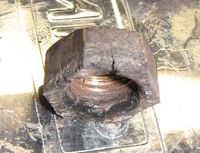  There are two obvious exhaust leaks. One is on the heat riser and the other is at the exhaust pipe flange. The flange leak was caused by the studs rusting away to the point where the nuts moved. Then the hot exhaust played hell with the brass nuts. So the studs will have to be replaced. There are two obvious exhaust leaks. One is on the heat riser and the other is at the exhaust pipe flange. The flange leak was caused by the studs rusting away to the point where the nuts moved. Then the hot exhaust played hell with the brass nuts. So the studs will have to be replaced. |
 The heat riser is another story. The heat riser’s job is to redirect warm exhaust around the intake manifold and carburetor base to help the engine warm up faster. It is automatic and controlled by a bimetallic spring and counterweight. You can see how it works in the pictures. Mine works but it looks like the cast-iron plate split right in half. Looks like it has been that way for a while. the good news is the moving parts are all intact and in good shape. Let’s go take a look at the spare engine… The heat riser is another story. The heat riser’s job is to redirect warm exhaust around the intake manifold and carburetor base to help the engine warm up faster. It is automatic and controlled by a bimetallic spring and counterweight. You can see how it works in the pictures. Mine works but it looks like the cast-iron plate split right in half. Looks like it has been that way for a while. the good news is the moving parts are all intact and in good shape. Let’s go take a look at the spare engine… |
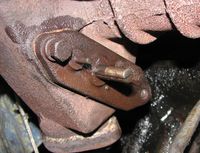 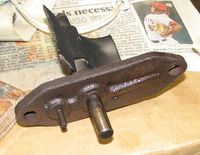 This looks promising. But the lower bolt is broken off and the shaft is frozen. I eventually had to use a hacksaw blade and cut out the broken bolt to get this off. The shaft is rusted into the plate and I am afraid to use drastic measures to get it out. I am likely to break this plate just like the the other one. So far I have heated it with a torch twice and tapped on it from all angles. I am hoping time, patience, and penetrating oil will get it off. This looks promising. But the lower bolt is broken off and the shaft is frozen. I eventually had to use a hacksaw blade and cut out the broken bolt to get this off. The shaft is rusted into the plate and I am afraid to use drastic measures to get it out. I am likely to break this plate just like the the other one. So far I have heated it with a torch twice and tapped on it from all angles. I am hoping time, patience, and penetrating oil will get it off. |
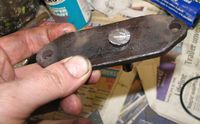 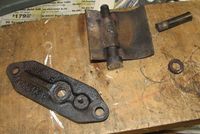 So much for patience. The shaft is mild steel and slotted down the middle. My tapping and heating distorted it badly so I broke down and just cut the damn thing off. After that a few minutes with a chisel and a punch was enough to get the it apart. I then mounted the plate in my drill press and chased the hole out. Good as new! So much for patience. The shaft is mild steel and slotted down the middle. My tapping and heating distorted it badly so I broke down and just cut the damn thing off. After that a few minutes with a chisel and a punch was enough to get the it apart. I then mounted the plate in my drill press and chased the hole out. Good as new! |
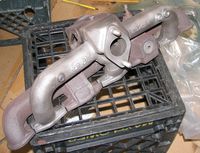  Got the manifold back from the machine shop. For $60 they removed the rusted studs and media blasted the manifold. That saved a ton of time. I cleaned it with acetone then applied Eastwood’s high-temp coating. It looks pretty good. This needs to dry for 48 hours then I can install the manifold. I also coated the heat riser parts. Got the manifold back from the machine shop. For $60 they removed the rusted studs and media blasted the manifold. That saved a ton of time. I cleaned it with acetone then applied Eastwood’s high-temp coating. It looks pretty good. This needs to dry for 48 hours then I can install the manifold. I also coated the heat riser parts. |
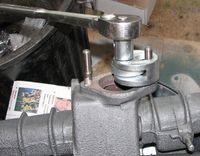 I could not find stainless studs but the old ones lasted almost 70 years so I probably should not worry about it. Here I am installing the new studs in the exhaust manifold. The silver goop is a high-temperature anti-seize. I use it on anything that might rust in place or get really hot. I could not find stainless studs but the old ones lasted almost 70 years so I probably should not worry about it. Here I am installing the new studs in the exhaust manifold. The silver goop is a high-temperature anti-seize. I use it on anything that might rust in place or get really hot. |
 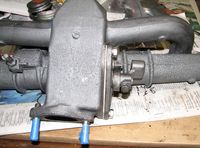 Time to assemble the heat riser. The only tricky part is installing that fragile and impossible to replace bimetallic spring. I put anti-seize from that blue can on everything to lubricate and protect. Then I used a new gasket and stainless hardware to install the heat riser. I scored a whole bag of these gaskets on e-Bay. The manifold is now officially done! I am a little concerned though. The heat riser plate I scored off my spare engine is not very flat. If I see any leakage I will have to rip this all apart again and get the plate machined flat. For now I will just wait and see what happens.. Time to assemble the heat riser. The only tricky part is installing that fragile and impossible to replace bimetallic spring. I put anti-seize from that blue can on everything to lubricate and protect. Then I used a new gasket and stainless hardware to install the heat riser. I scored a whole bag of these gaskets on e-Bay. The manifold is now officially done! I am a little concerned though. The heat riser plate I scored off my spare engine is not very flat. If I see any leakage I will have to rip this all apart again and get the plate machined flat. For now I will just wait and see what happens.. |

 There are two obvious exhaust leaks. One is on the heat riser and the other is at the exhaust pipe flange. The flange leak was caused by the studs rusting away to the point where the nuts moved. Then the hot exhaust played hell with the brass nuts. So the studs will have to be replaced.
There are two obvious exhaust leaks. One is on the heat riser and the other is at the exhaust pipe flange. The flange leak was caused by the studs rusting away to the point where the nuts moved. Then the hot exhaust played hell with the brass nuts. So the studs will have to be replaced. The heat riser is another story. The heat riser’s job is to redirect warm exhaust around the intake manifold and carburetor base to help the engine warm up faster. It is automatic and controlled by a bimetallic spring and counterweight. You can see how it works in the pictures. Mine works but it looks like the cast-iron plate split right in half. Looks like it has been that way for a while. the good news is the moving parts are all intact and in good shape. Let’s go take a look at the spare engine…
The heat riser is another story. The heat riser’s job is to redirect warm exhaust around the intake manifold and carburetor base to help the engine warm up faster. It is automatic and controlled by a bimetallic spring and counterweight. You can see how it works in the pictures. Mine works but it looks like the cast-iron plate split right in half. Looks like it has been that way for a while. the good news is the moving parts are all intact and in good shape. Let’s go take a look at the spare engine…
 This looks promising. But the lower bolt is broken off and the shaft is frozen. I eventually had to use a hacksaw blade and cut out the broken bolt to get this off. The shaft is rusted into the plate and I am afraid to use drastic measures to get it out. I am likely to break this plate just like the the other one. So far I have heated it with a torch twice and tapped on it from all angles. I am hoping time, patience, and penetrating oil will get it off.
This looks promising. But the lower bolt is broken off and the shaft is frozen. I eventually had to use a hacksaw blade and cut out the broken bolt to get this off. The shaft is rusted into the plate and I am afraid to use drastic measures to get it out. I am likely to break this plate just like the the other one. So far I have heated it with a torch twice and tapped on it from all angles. I am hoping time, patience, and penetrating oil will get it off.
 So much for patience. The shaft is mild steel and slotted down the middle. My tapping and heating distorted it badly so I broke down and just cut the damn thing off. After that a few minutes with a chisel and a punch was enough to get the it apart. I then mounted the plate in my drill press and chased the hole out. Good as new!
So much for patience. The shaft is mild steel and slotted down the middle. My tapping and heating distorted it badly so I broke down and just cut the damn thing off. After that a few minutes with a chisel and a punch was enough to get the it apart. I then mounted the plate in my drill press and chased the hole out. Good as new!
 Got the manifold back from the machine shop. For $60 they removed the rusted studs and media blasted the manifold. That saved a ton of time. I cleaned it with acetone then applied Eastwood’s high-temp coating. It looks pretty good. This needs to dry for 48 hours then I can install the manifold. I also coated the heat riser parts.
Got the manifold back from the machine shop. For $60 they removed the rusted studs and media blasted the manifold. That saved a ton of time. I cleaned it with acetone then applied Eastwood’s high-temp coating. It looks pretty good. This needs to dry for 48 hours then I can install the manifold. I also coated the heat riser parts. I could not find stainless studs but the old ones lasted almost 70 years so I probably should not worry about it. Here I am installing the new studs in the exhaust manifold. The silver goop is a high-temperature anti-seize. I use it on anything that might rust in place or get really hot.
I could not find stainless studs but the old ones lasted almost 70 years so I probably should not worry about it. Here I am installing the new studs in the exhaust manifold. The silver goop is a high-temperature anti-seize. I use it on anything that might rust in place or get really hot.
 Time to assemble the heat riser. The only tricky part is installing that fragile and impossible to replace bimetallic spring. I put anti-seize from that blue can on everything to lubricate and protect. Then I used a new gasket and stainless hardware to install the heat riser. I scored a whole bag of these gaskets on e-Bay. The manifold is now officially done! I am a little concerned though. The heat riser plate I scored off my spare engine is not very flat. If I see any leakage I will have to rip this all apart again and get the plate machined flat. For now I will just wait and see what happens..
Time to assemble the heat riser. The only tricky part is installing that fragile and impossible to replace bimetallic spring. I put anti-seize from that blue can on everything to lubricate and protect. Then I used a new gasket and stainless hardware to install the heat riser. I scored a whole bag of these gaskets on e-Bay. The manifold is now officially done! I am a little concerned though. The heat riser plate I scored off my spare engine is not very flat. If I see any leakage I will have to rip this all apart again and get the plate machined flat. For now I will just wait and see what happens..
Pingback: Valve adjustment and new starter cable | 1941 Studebaker Champion